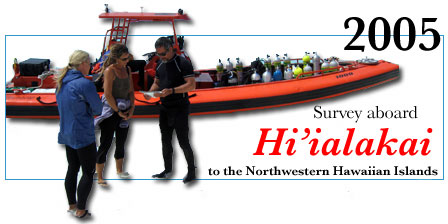
During the 2005 NWHI survey, a team of NOAA MHP archaeologists worked for extended periods of time at both Pearl and Hermes Atoll and Kure Atoll. The survey team including principal investigator Hans Van Tilburg, John Broadwater, Tane Casserley, Robert Schwemmer and Kelly Gleason along with director/film makers John Brooks and John Lindsay spent 25 days studying several 19th century whaling shipwreck sites. The shipwreck survey in the Northwestern Hawaiian Islands was one component of the multidisciplinary cruise which also included coral disease survey, fish genetic connectivity, shark and large jack tagging, and seafloor mapping. This expedition was an incredible collaborative effort and was successful due to the efforts of the maritime heritage team as well as the entire crew of the R/V Hi'ialakai who made field work in this remote region possible.
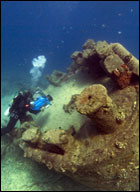 |
| John Brooks filming USS Macaw site, Midway Atoll. (Photo: Robert Schwemmer, NOAA NMSP) |
|
|
During the 2005 survey of the Pearl and Hermes Atoll whaling shipwreck sites discovered a year earlier by the CRED's marine debris team, fixed baselines were established at two fore reef sites, and maritime archaeologists then collected photo documentation and data for a plan view drawing of the wreckage. Numerous previously undiscovered artifacts, such as anchors, trypots (cauldrons for rendering the whale oil), and portions of the tryworks (structures built to house the trypots) were added to the site inventory.
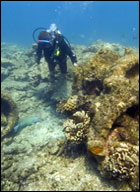 |
| Diver and windlass at Carrollton site, Midway Atoll. (Photo: Tane Casserley, NOAA NMSP) |
|
|
Divers have now identified six cannons, seven trypots, five anchors, and numerous other artifacts for these sites. The shallow surf and surge zone is where the British whalers Pearl and Hermes (from which the atoll was named) ran aground on April 24th, 1822. All archaeological and historical evidence suggests these are indeed the same vessels. The ships were on their way from Honolulu to waters off of Japan for whales when they crashed into the reef, the castaways spending months surviving on nearby Southeast Island. The small schooner Deliverance was constructed on a nearby island, and 12 survivors sailed back to Honolulu. The rest were picked up by a passing ship.
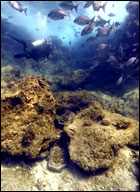 |
| Diver swimming through reef at Carrollton site, Midway Atoll. (Photo: Tane Casserley, NOAA NMSP) |
|
|
At Kure Atoll, where the entire bow section of a 19th century wooden sailing ship was lifted over the reef and deposited inside the lagoon, four anchors, chain, windlass, rigging and deck machinery lie scattered amidst the coral. This ship may be the American whaler Parker lost in 1842 during a storm, the castaways making their way to Green Island. The maritime archaeologists established a fixed baseline at this site and collected photo documentation of the site.
In addition to the sites documented at Pearl and Hermes and Kure Atolls, the team discovered two shipwrecks, a landing craft or barge at French Frigate Shoals and a modern vessel (likely the Mimi) lost at Pearl and Hermes Atoll in 1989. In addition, partner researchers on board the NOAA R/V Hi'ialakai found coal in the western passage at Kure Atoll, the area where the iron sailing bark Dunnottar Castle (carrying a cargo of coal from Sydney to California) ran aground in 1886. This is the start of a new "shipwreck trail," providing archaeologists with clues leading to the location of the wreck site.
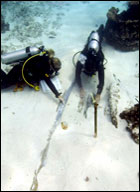 |
| Archaeologists documenting whaling shipwreck site, Pearl and Hermes Atoll. (Photo: Tane Casserley, NOAA NMSP) |
|
|
NOAA's Ocean Media Center brought high definition video equipment to document the wreck sites, providing researchers with a detailed record of artifacts and site views, and at the same time collecting footage suitable for public outreach and education. Heritage preservation and resource stewardship were important messages associated with this survey. In addition to spectacular coverage of the historic whaling shipwrecks, as well as the USS Macaw, the US Navy submarine rescue vessel lost at Midway in 1944 (and now a habitat for fish), the film team documented the Carrollton, the American sailing bark lost at Midway in 1906. All of these sites help tell the story of our human relationship to the sea and educates the public about the potential for maritime heritage research in the Hawaiian archipelago and the dynamic environment of the Northwestern Hawaiian Islands.

Additional Resources and Links
Northwestern Hawaiian Islands Coral Reef Ecosystem Reserve
Northwestern Hawaiian Islands Multi-Agency Education Project
|





